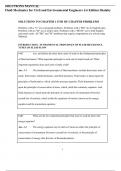Exam (elaborations)
Solutions Manual Fluid Mechanics for Civil and Environmental Engineers 1st Edition by Ahlam Shalaby
- Course
- Institution
Solutions, Solutions Manual Fluid Mechanics for Civil and Environmental Engineers 1st Edition by Ahlam Shalaby. ISBN. 9780849337376.
[Show more]



